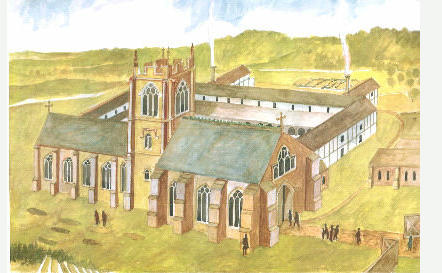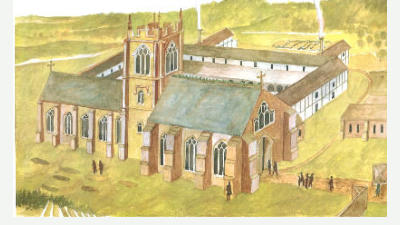


Pontefract & District
Archaeology & History Society

Looking forward…to learning more about our past
St Richard’s Dominican
Friary, Pontefract
The Dominican Order was founded in 1216 at
Toulouse, S W France. The Dominican mission to
Britain arrived in 1221, with the first Friary founded at
Oxford, then York by 1227 and Pontefract by 1256.
Eventually there were 59 Dominican Friaries in Britain.
The Dominicans’ mission was to preach and counter heresy. The friars were trained preachers, “racy, provocative, entertaining and informative”. St Richard’s Friary was founded on land donated by Edmund de Lacy at the edge of Pontefract, as the town was full of buildings and no site big enough for an urban monastery was available. The Black Friars owned nothing, and begged the Friary site, stone, builders, food, clothing and all else. Giving to the friars was seen as an act of Christian charity by the population. The Pontefract Black Friars were allocated a territory in which to preach and beg, encompassed by Pontefract, Rotherham and Wakefield. From 1330 onwards, the Pope awarded the Friars the power to preach, hear confessions and bury the dead. Many townsfolk in Pontefract left small legacies to the Friars and requested to be buried in the Friary lay cemetery.



The Friary comprised a large ‘preaching box’ nave with narrow chancel, and cloister,
dormitory, chapter house, refectory, kitchens, lavatories and guest accommodation. All
the Friary buildings lay south of the church, ranged around the cloister, and today lie
below the demolished former hospital site.
The Friary was dissolved by King Henry VIII in 1538 and surrendered to the Crown. The
two bells and roof lead were stripped and sold, as was the entire site. The buildings were
demolished for their stone, wood, glass and fittings, which were sold. The site reverted to
agricultural use as pasture and later became liquorice fields. The hospital eventually
spread over the site after the foundation of the Dispensary in the late 1890’s.
PDAS has long been involved in
archaeological excavations at St
Richard’s:
1963 dig
2011 dig
2012 dig
The reconstruction of what we think the
Friary site looked like in the C15th has
been drawn by Ron Wilson, based on
Information from the 2011 excavations
and from previous digs.


Pontefract & District
Archaeology & History Society

Looking forward…to learning more about our past

St Richard’s
Dominican Friary,
Pontefract
The Dominican Order was founded in 1216
at Toulouse, S W France. The Dominican
mission to Britain arrived in 1221, with the
first Friary founded at Oxford, then York by
1227 and Pontefract by 1256. Eventually
there were 59 Dominican Friaries in Britain.
The Dominicans’ mission was to preach and counter heresy. The friars were trained preachers, “racy, provocative, entertaining and informative”. St Richard’s Friary was founded on land donated by Edmund de Lacy at the edge of Pontefract, as the town was full of buildings and no site big enough for an urban monastery was available. The Black Friars owned nothing, and begged the Friary site, stone, builders, food, clothing and all else. Giving to the friars was seen as an act of Christian charity by the population. The Pontefract Black Friars were allocated a territory in which to preach and beg, encompassed by Pontefract, Rotherham and Wakefield. From 1330 onwards, the Pope awarded the Friars the power to preach, hear confessions and bury the dead. Many townsfolk in Pontefract left small legacies to the Friars and requested to be buried in the Friary lay cemetery.
The Friary comprised a large ‘preaching box’ nave with narrow
chancel, and cloister, dormitory, chapter house, refectory,
kitchens, lavatories and guest accommodation. All the Friary
buildings lay south of the church, ranged around the cloister,
and today lie below the demolished former hospital site.
The Friary was dissolved by King Henry VIII in 1538 and
surrendered to the Crown. The two bells and roof lead were
stripped and sold, as was the entire site. The buildings were
demolished for their stone, wood, glass and fittings, which
were sold. The site reverted to agricultural use as pasture and
later became liquorice fields. The hospital eventually spread
over the site after the foundation of the Dispensary in the late
1890’s.
PDAS has long been involved in
archaeological excavations at St
Richard’s:
1963 dig
2011 dig
2012 dig
The reconstruction of what we think the
Friary site looked like in the C15th has
been drawn by Ron Wilson, based on
Information from the 2011 excavations
and from previous digs.
© All text and photographs on this site are copyright. All rights reserved. Please contact the
Society for further information.



















